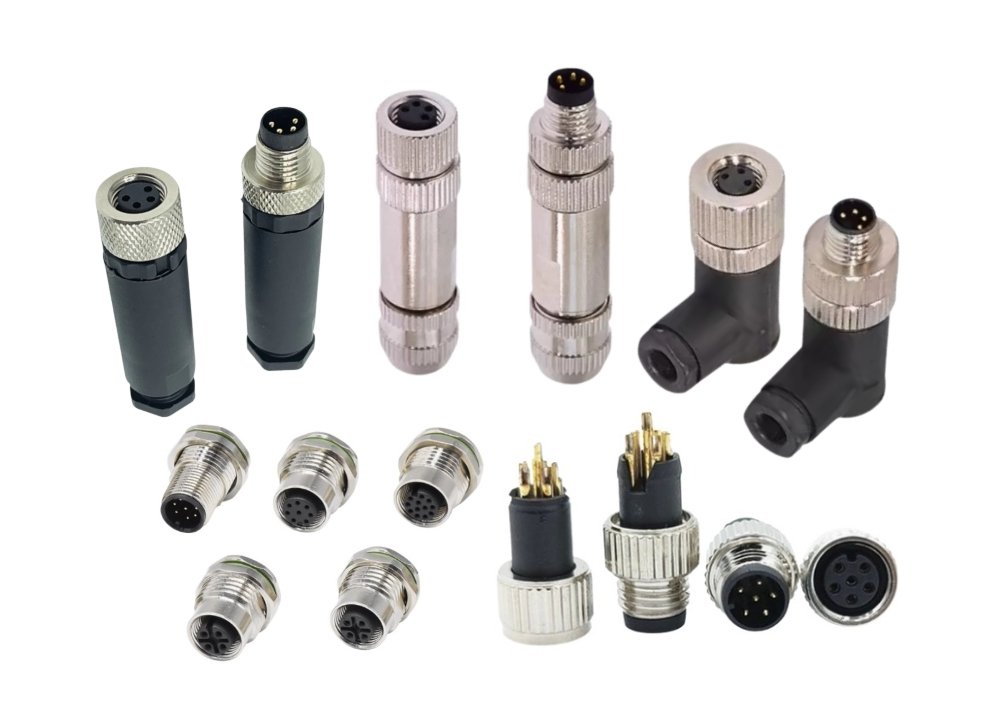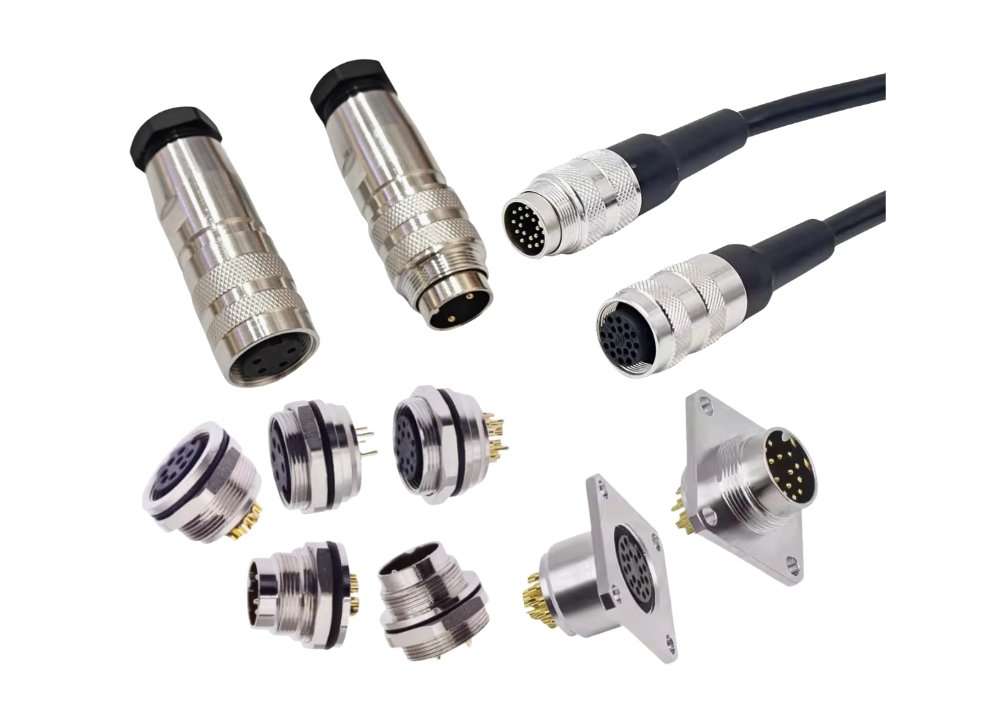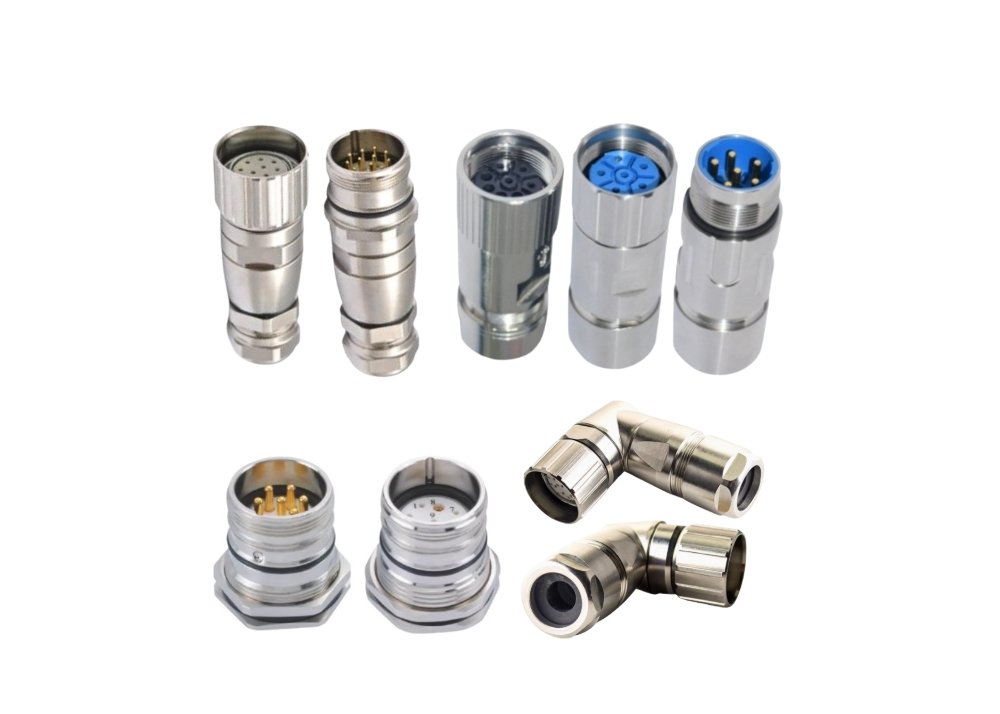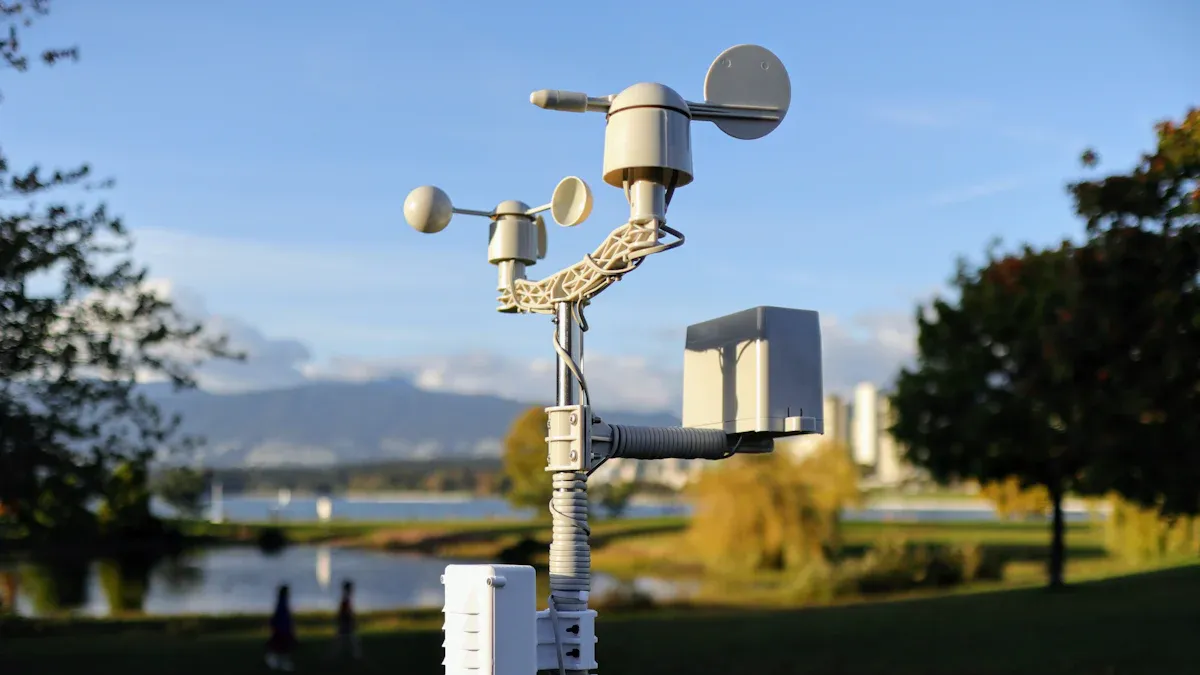
You depend on m16.12 connectors to deliver a reliable connection in demanding industrial settings. These circular connectors provide waterproof protection, keeping your sensor systems safe from dust and moisture. Industries such as automation, marine technology, and medical equipment trust these solutions for their robust design and IP67 rating. Connector factory standards ensure durability, while options like the M8 connector and Type B connector address different needs. With the growing global market for these connectors, you gain peace of mind knowing your applications receive the best protection and performance.
M16.12 Connectors: Circular Waterproof Solutions for Sensors
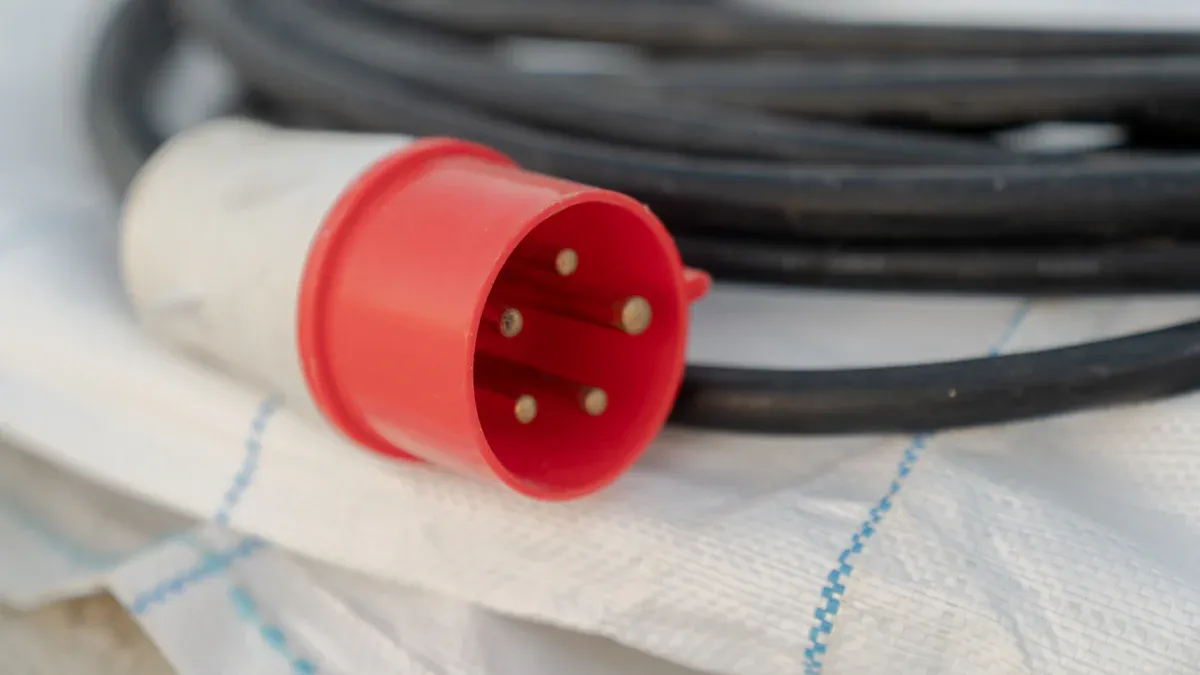
Definition and Overview of M16.12 Connectors
What is an M16.12 connector?
You encounter M16.12 connectors in many industrial and automation systems. These circular connectors feature a 16 mm diameter and 12 contact pins, making them ideal for complex sensor and control wiring. You benefit from their robust screw-locking system, which ensures a secure fit and prevents accidental disconnection. The design supports both signal and power transmission, giving you flexibility in demanding environments.
Key features and design of circular connectors
Circular connectors like the M16.12 offer several advantages for sensor integration. You get a compact form factor that simplifies installation in tight spaces. The connectors use a threaded coupling ring for reliable locking, which you can hand-tighten to about 60 cNm. The housing, made from nickel-plated zinc die-cast, resists corrosion and mechanical stress. Gold-plated brass contacts provide excellent conductivity and minimize signal loss. You also gain from their high insulation resistance and mechanical durability, with over 500 mating cycles.
Tip: Always ensure you do not plug or unplug connectors under load. This practice prevents personal injury and protects your equipment.
You can review the key technical specifications for M16.12 connectors in the table below:
| Specification Category | Details |
|---|---|
| Connector Type | Male cable connector, 12 contacts |
| Locking System | Screw locking |
| Termination | Solder |
| Protection Class | IP40 |
| Rated Voltage | 60 V |
| Rated Current | 3.0 A |
| Rated Impulse Voltage | 500 V |
| Insulation Resistance | ≥ 10^10 Ω |
| Pollution Degree | 1 |
| Overvoltage Category | I |
| Housing Material | Zinc die-cast, nickel-plated |
| Contact Material | Brass (CuZn) with gold plating |
| Temperature Range | -40 °C to 85 °C |
| Mechanical Durability | > 500 mating cycles |
| Cable Connection Cross-Section | Max. 0.25 mm² / AWG 24 |
| EMC Compliance | Shieldable with solder lug shield connection |
| Compliance Directives | Low Voltage Directive 2014/35/EU (EN 60529, EN 60204-1) |
Importance of Waterproof Electrical Connectors in Sensor Connections
Role in signal integrity and protection
You rely on waterproof circular connectors to maintain signal integrity in your sensor networks. These connectors use multi-point sealing, O-rings, and potting compounds to block moisture and contaminants. The result is a stable electrical connection that resists dust, water, and chemical ingress. You avoid signal loss and intermittent faults, which often occur when moisture or dust penetrates standard connectors. High-quality seals and corrosion-resistant materials ensure your sensors operate reliably, even in challenging conditions.
Impact on system reliability in harsh environments
When you deploy sensors in harsh environments, you face threats like water, extreme temperatures, vibration, and chemicals. Waterproof circular connectors with high IP ratings, such as IP67 or IP68, provide dust-tight sealing and withstand water immersion. These features protect your sensor systems from failure and costly downtime. You also benefit from rigorous testing to IEC 60529 standards, which guarantees performance under vibration, temperature swings, and chemical exposure. Industries such as marine, transportation, and outdoor infrastructure depend on these connectors for reliable watertight electrical interconnections.
- Waterproof connectors prevent moisture and contaminant ingress, which is crucial for reliable electrical connections in harsh environments.
- They withstand extreme temperatures, chemical exposure, and UV radiation, broadening their applicability.
- Failures in these connectors can cause costly downtime and safety hazards, emphasizing the importance of proper selection and installation.
Comparison to Other Circular Connectors
Differences from M12 and M8 connectors
You may wonder how M16.12 connectors compare to other popular circular connectors like M12 connectors and M8 connectors. M8 connectors are smaller, typically used for compact sensors and low-power signals. M12 connectors offer a balance between size and versatility, supporting both signal and low-power applications. M16.12 connectors, however, provide more contact pins and higher current capacity, making them suitable for complex sensor arrays and power transmission.
| Feature | M16 Circular Connectors | M12 Connectors | M8 Connectors |
|---|---|---|---|
| Diameter | 16 mm | 12 mm | 8 mm |
| Number of Contacts | Up to 12 | Up to 8 | Up to 6 |
| Rated Current | Up to 3.0 A | Up to 4.0 A | Up to 2.0 A |
| Protection Grade | IP67/IP68 | IP67/IP68 | IP67/IP68 |
| Application | Power & complex signal | Signal & low power | Compact sensors |
Advantages of M16.12 connectors for industrial use
You gain several advantages by choosing M16.12 connectors for industrial applications. These connectors deliver excellent electromagnetic interference (EMI) shielding, which protects your signals from external noise. The IP67 rating ensures waterproof and dustproof performance, even in outdoor or washdown environments. You can use them for both power and signal connections, supporting higher electrical loads than M12 connectors or M8 connectors. Their robust construction and customization options make them ideal for demanding tasks, such as servo motor systems and automation equipment.
Industry reports confirm that M16 circular connectors withstand harsh environments and provide reliable IP67/69-rated protection. You can rely on their performance for both power and signal transmission, especially in applications where you need higher voltage and current capacity. Their durability and flexibility set them apart from smaller circular connectors, making them a preferred choice for industrial automation, process control, and outdoor sensor installations.
Key Specifications of M16.12 Connectors
Physical Dimensions and Construction
Size, pin configuration, and cable compatibility
You work with M16.12 connectors when you need reliable circular connections for sensors and automation equipment. These connectors feature a 16 mm thread diameter, which matches the standard for industrial circular connectors. You often see pin counts ranging from 2 to 24, but the 12-pin configuration is common for sensor applications. The pin arrangement prevents mismating and ensures only compatible sensor cables connect securely.
| Parameter | M16 Connectors |
|---|---|
| Connector Size | 16 mm thread diameter |
| Pin Count | 2 to 24 pins (common: 4, 8, 12 pins) |
| Typical Applications | High-current/high-voltage (motors, power distribution) |
| Current/Voltage Rating | Up to ~250 V; typically ≥16 A |
| IP Rating | Typically IP67 (cable variants up to IP68) |
| Mechanical Lifespan | ≥500 mating cycles |
You select cables with aperture sizes between 4.0 mm and 10.0 mm, depending on the connector model. This range allows you to match the cable diameter to your sensor requirements. The physical and electrical design of these connectors ensures compatibility with sensor cables that meet the pin count and coding specifications. You avoid connection errors and mismating by choosing the correct pin configuration.
Materials and robust construction for durability
You benefit from the robust construction of M16.12 connectors in harsh environments. The outer housing uses nickel-plated brass, which provides excellent protection against vibration and shock. You rely on gold or silver-plated contacts to prevent corrosion and maintain signal integrity. The M16 x 0.75 screw thread locking system secures the connection and resists accidental disconnection. You experience over 100 mating cycles and a maximum insertion force of 60N, which ensures long-term reliability. The cable retention force reaches 80N, so your connections stay secure even under mechanical stress.
Note: The 360° metal shielding available in these connectors meets DIN 47250-6 standards, giving you strong EMI protection for sensitive sensor signals.
IP Ratings and Waterproof Performance
Water and dust resistance standards
You depend on IP rated circular connections to protect your sensor systems from dust and water. M16.12 connectors achieve IP68 ratings, which means they are completely dustproof and can withstand prolonged immersion under pressure. You use these waterproof connectors in environments where continuous water exposure is a risk. The IP rating consists of two digits: the first digit (6) indicates total dust protection, and the second digit (8) means the connector can handle continuous immersion in water beyond 1 meter depth.
| Connector Type | Typical IP Rating | Dustproof Level | Waterproof Level | Meaning |
|---|---|---|---|---|
| M16 Connectors | IP68 | 6 (completely dustproof) | 8 (prolonged immersion under pressure) | Suitable for harsh, wet environments with continuous water exposure protection |
You choose waterproof electrical connectors with IP68 ratings when you need maximum protection for your sensor installations. These connectors keep out dust and water, so your equipment operates reliably in industrial and outdoor settings.
Temperature and chemical tolerance for industrial settings
You face extreme temperatures and chemical exposure in many industrial environments. M16.12 connectors withstand temperatures from -40°C to 85°C, so you can use them in both hot and cold conditions. The nickel-plated brass housing resists corrosion from chemicals and moisture. You rely on these waterproof connectors to maintain performance even when exposed to oils, solvents, and cleaning agents. The robust construction and high IP ratings ensure your sensor connections remain secure and functional in harsh environments.
Coding and Pin Arrangements in Circular Connectors
Standard coding options for M16.12 connectors
You select coding options to prevent mismating and ensure correct connections. M16.12 connectors offer several standard coding types, such as keyways and color codes. These coding systems help you match connectors with the correct pin count and arrangement. You avoid connection errors and signal loss by using coded connectors in your sensor networks.
Tip: Always verify the coding before installation to ensure compatibility with your sensor system.
Pin layouts and compatibility with sensor systems
You work with pin layouts that match your sensor requirements. M16.12 connectors support multiple pin arrangements, including 2, 4, 8, and 12-pin layouts. You choose the layout based on the number of signals or power lines needed for your application. The physical design of these circular connectors ensures only compatible cables and sensors connect, reducing the risk of mismating. You maintain signal integrity and system reliability by selecting the correct pin configuration for your sensor systems.
Electrical Characteristics of Waterproof Electrical Connectors
Voltage and current ratings for M16.12 connectors
You rely on M16.12 connectors to deliver consistent electrical performance in sensor applications. These circular connectors support a range of voltage and current ratings, which you must match to your system requirements. The rated voltage and impulse voltage depend on the contact arrangement. You can review the typical values in the table below:
| Contact Arrangement | Typical Rated Voltage (V) | Rated Impulse Voltage (kV) |
|---|---|---|
| 02-a, 03-a, 04-a | 100 | 1.5 |
| 05-a, 06-a, 07-a | 63 | 1.5 |
| 05-b, 07-b, 08-a, 012-a, 14-a, 14-b, 19-a | 32 | 0.8 |
A standard M16 male cable connector, compliant with DIN EN 61076-2-106, offers a rated voltage of 60 V and a rated current of 3.0 A. You benefit from a rated impulse voltage of 500 V, which protects your sensor circuits against transient surges. The connector supports a maximum connection cross-section of 0.25 mm² (AWG 24), making it suitable for fine sensor wiring.
You can visualize the voltage and impulse ratings for different contact arrangements in the chart below:
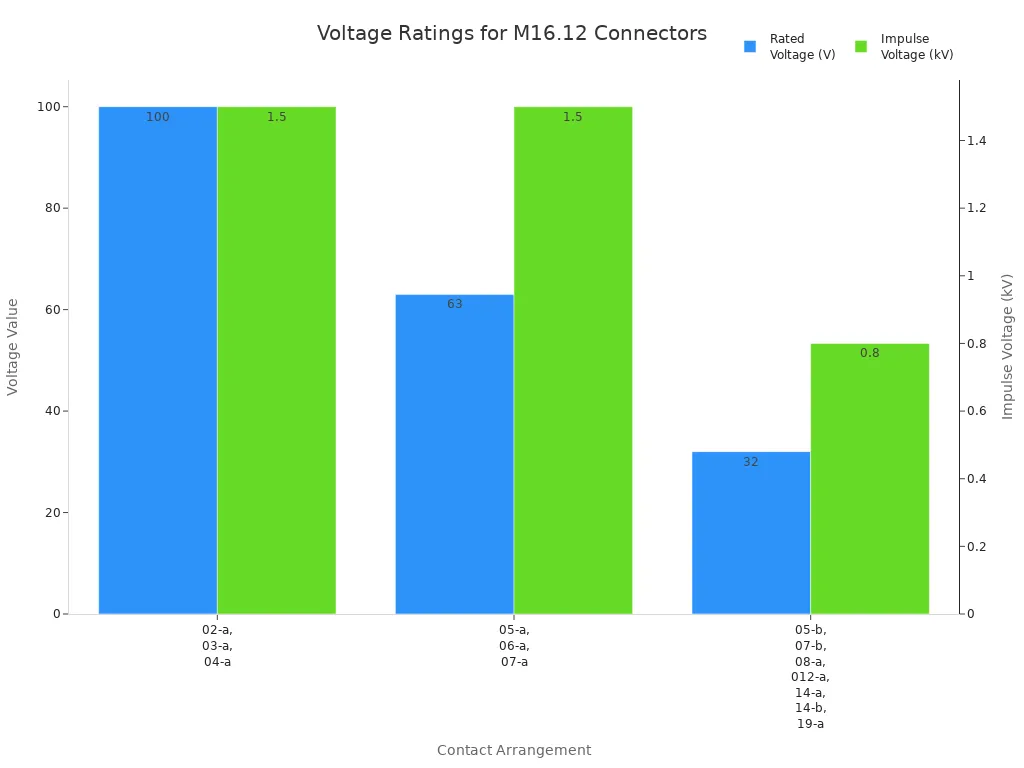
You must select connectors with voltage and current ratings that match your sensor and automation needs. This ensures safe operation and prevents overloads. The robust design and high IP ratings of these waterproof connectors help you maintain reliable performance, even in demanding industrial environments.
Tip: Always check the rated voltage and current before installation. This step helps you avoid electrical faults and ensures compliance with safety standards.
Supported signal types and data transmission
You use circular connectors like the M16.12 to transmit a variety of signals and power. These connectors support analog, digital, and power signals, making them versatile for sensor integration. The coding system allows you to customize pin layouts for specific functions. You can review the supported signal types and typical applications in the table below:
| Coding Type | Supported Signals | Voltage Range | Current Rating | Protection Level | Typical Applications |
|---|---|---|---|---|---|
| A-coded | Analog and digital signals, DC power | 30 – 250 VAC | 1.5 – 8 A | IP67/IP68/IP69K | Power, Signal, CAN, CANopen, PROFIBUS PA, DeviceNet |
| B-coded | Digital signals (PROFIBUS) | 60 – 250 VAC | 4 A | IP67/IP68 | PROFIBUS DP |
| D-coded | Digital signals (Ethernet, PROFINET, EtherCAT) | 250 VAC | 4 A | IP67 | Ethernet, EtherCAT, PROFINET, Sercos |
| X-coded | High-speed digital data (10 Gbit Ethernet) | N/A | N/A | N/A | Gigabit Ethernet, Industrial Ethernet |
| S-coded, K-coded | AC power supplies | Up to 630 V AC | Up to 16 A | N/A | AC motors, drives, motor control switches, frequency inverters |
| T-coded, L-coded | DC power supplies | Up to 63 V DC | Up to 16 A | N/A | DC motors, fieldbus Ethernet components, network devices, LED lighting |
You can see how different coding types enable you to use connectors for analog sensor signals, digital data, and power transmission. The circular design and waterproof construction allow you to deploy these connectors in harsh environments, where high IP ratings protect against dust and moisture.
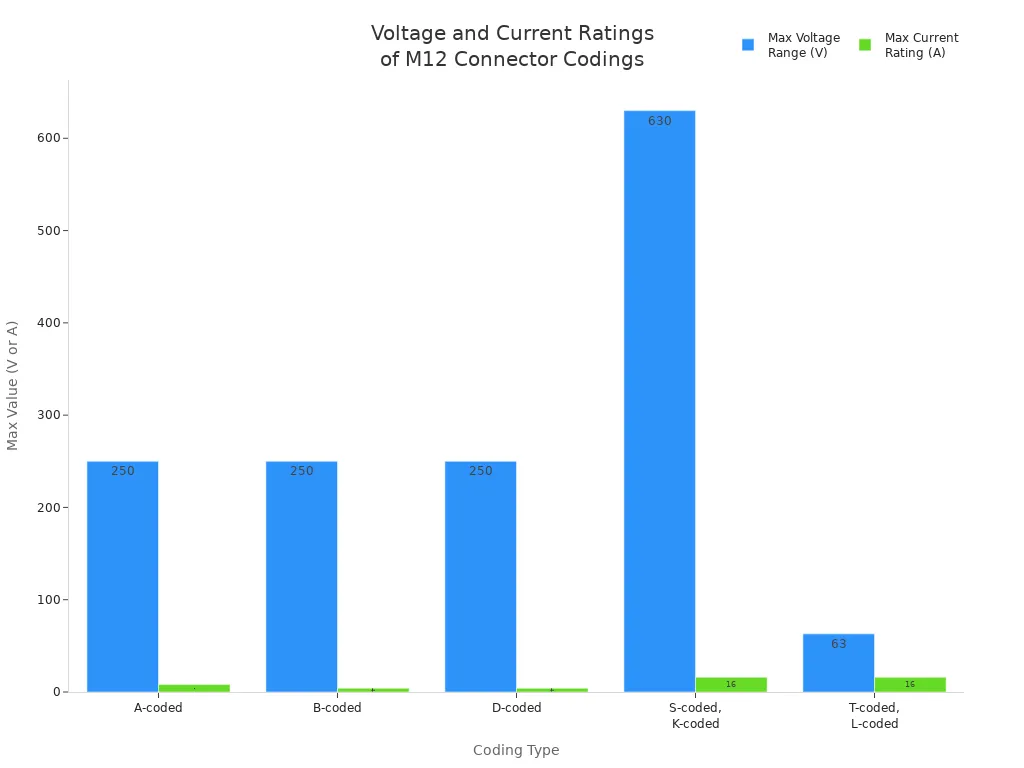
You benefit from integrated data transmission capabilities, including support for industrial Ethernet and fieldbus protocols. Some coding types, such as X-coded, allow you to achieve data rates up to 10 Gbit Ethernet. You can connect sensors, actuators, and network devices using the same waterproof electrical connectors, simplifying your system architecture.
Note: The high ingress protection ratings (IP67 and above) and EMI shielding in circular connectors ensure stable signal transmission, even in environments with electrical noise or moisture.
You must choose the right coding and pin arrangement to match your signal type and data requirements. This step helps you optimize performance and maintain reliability in your sensor networks.
Typical Applications of M16.12 Connectors
You encounter M16.12 connectors in a wide range of industrial applications. Their circular design and robust construction make them essential for reliable sensor integration, machine connections, and specialized equipment. You benefit from their high pin count, strong EMI shielding, and waterproof performance, which support stable data and power transmission in demanding environments.
Sensor Integration in Industrial Automation
Temperature, pressure, and liquid level sensors
You use M16.12 connectors to link temperature, pressure, and liquid level sensors in automated systems. These connectors provide secure and interference-resistant connections, ensuring accurate sensor readings. You rely on their IP67 rating to protect against dust and moisture, which is critical for maintaining sensor performance in harsh industrial settings. You often see these connectors in process control modules, automated assembly lines, and chemical plants, where reliable data transmission is vital.
Tip: Choose circular connectors with high pin counts for complex sensor arrays. This approach simplifies wiring and enhances system efficiency.
Environmental monitoring systems using waterproof connectors
You deploy environmental monitoring systems in aquaculture, water treatment, and outdoor infrastructure. M16.12 connectors offer up to 24 contacts, robust EMI shielding, and secure locking mechanisms. You trust these connectors to deliver stable signal transmission, even when exposed to water, dust, and temperature fluctuations. Their waterproof properties and anti-interference capabilities make them ideal for monitoring air quality, water levels, and other environmental parameters.
Machine and Equipment Connections with Circular Connectors
Robotics and motion control systems
You integrate M16.12 connectors into robotics and motion control systems for reliable power and signal transmission. These connectors connect modules at robot joints, such as motion control, force, and camera modules. You benefit from their internal strain relief, metal locking rings, and vibration resistance, which support high-speed and precise operations. You also use inline connectors for easy on-site wiring and quick maintenance.
- M16.12 connectors enhance equipment synergy and reliability in CNC machines and automation equipment.
- You achieve high data transmission speeds and adapt to different cable installation methods, making these connectors suitable for complex machine connections.
Process control equipment in manufacturing
You rely on M16.12 connectors for process control equipment in manufacturing environments. Their compact design supports up to 250V and 5A, making them suitable for control signals, power, and sensor interfaces. You value their IP67/IP68 protection rating, which ensures resistance to dust, moisture, and corrosive substances. Multi-core configurations allow you to transmit signals and power together, reducing wiring complexity. You also benefit from excellent shielding structures that maintain signal integrity in industrial communication.
| Feature | Benefit for Manufacturing Applications |
|---|---|
| High electrical performance | Supports control signals and power |
| IP67/IP68 protection | Reliable in harsh environments |
| Multi-core configurations | Mixed signal and power transmission |
| Shielding structure | Resists electromagnetic interference |
| Vibration resistance | Reliable installation and maintenance |
Other Industrial and Specialized Applications
Transportation and automotive systems
You find M16.12 connectors in transportation and automotive systems, where durability and waterproofing are essential. These connectors support sensor integration for vehicle diagnostics, control modules, and monitoring devices. You use inline connectors to simplify installation and maintenance in confined spaces.
Renewable energy installations and marine equipment
You apply M16.12 connectors in renewable energy installations, such as solar PV systems and inverters. Their rugged design and high current capacity make them suitable for power distribution and monitoring devices. You also use these connectors in marine equipment, where resistance to water, salt, and vibration is critical for long-term reliability. You often choose m12 connectors for smaller sensor applications, but M16.12 connectors provide higher pin counts and power capacity for demanding tasks.
Note: Select circular connectors with appropriate IP ratings for outdoor and marine applications. This choice ensures reliable operation under extreme conditions.
You see M16.12 connectors used across many industrial sectors. Their versatility, durability, and ease of use make them a preferred solution for sensor integration, machine connections, and specialized applications.
Installation Best Practices for Waterproof Electrical Connectors
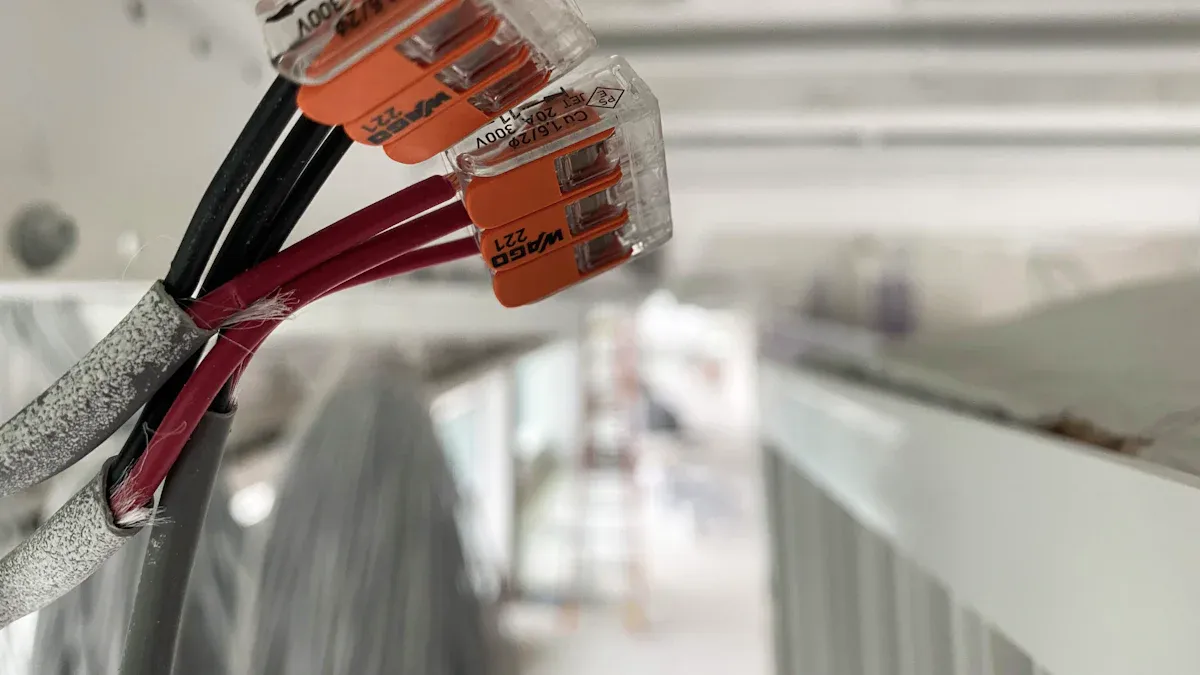
Preparation and Planning for M16.12 Connectors
Selecting the right connector for your application
You start by identifying the requirements of your sensor system. M16.12 connectors offer multiple pin counts, locking mechanisms, and housing materials. You select connectors with gold-plated brass contacts for low resistance and corrosion protection. For high current applications, you choose silver-plated copper contacts. You match the wire gauge to your current load, such as 18 AWG for 10A at 12V DC. You consider panel mount types—front or rear—based on accessibility and the level of protection needed.
Checking compatibility and environmental requirements
You check the compatibility of your connectors with the cables and devices in your system. You verify the pin configuration and coding to prevent mismating. You assess the environmental conditions, including exposure to moisture, dust, chemicals, and temperature extremes. You select waterproof connectors with IP67 or IP68 ratings for outdoor or harsh environments. You ensure the housing material, such as UV-stable nylon or chemical-resistant PBT, matches your application’s needs.
Step-by-Step Installation Guide for Circular Connectors
Cable preparation and handling
You begin by preparing your cables. You strip the insulation carefully to avoid damaging the conductors. You use precision crimping tools to attach contacts, ensuring low resistance and a reliable connection. You apply dual-wall insulation for voltage isolation and shield the cable with braided tinned copper and foil to reduce EMI.
Connector assembly and secure locking
You assemble the circular connectors by aligning the keyways and pin layouts. You use threaded coupling nuts or screw-lock mechanisms for secure, vibration-resistant connections. You avoid over-tightening, which can damage the connector or compromise the seal. You check that the locking ring is fully engaged to prevent accidental disconnection.
Ensuring proper sealing for waterproof performance
You inspect the seals, such as silicone or FKM O-rings, before final assembly. You use overmolding at wire exits to prevent water ingress. You verify that all gaskets and seals are seated correctly. You test the assembled connector for waterproof performance, especially if you plan to use it in environments with high-pressure cleaning or immersion.
Tip: Always conduct a visual inspection after installation to confirm that seals and locking mechanisms are intact.
Ensuring Reliability in Waterproof Electrical Connectors
Proper tightening and sealing techniques
You tighten connectors to the manufacturer’s recommended torque. You avoid under-tightening, which can lead to leaks, and over-tightening, which may damage seals. You use strain relief ribs to reduce flex fatigue and maintain a reliable connection.
Testing connections for signal integrity
You test your waterproof electrical connectors using HiPot testing at 1,500V AC for one minute to verify insulation. You perform salt spray testing for corrosion resistance, especially in marine or outdoor applications. You check for low contact resistance and stable signal transmission. You confirm that the connectors meet certifications such as UL 1977, CE, RoHS, and REACH for safety and reliability.
Note: Reliable connection starts with careful planning, precise assembly, and thorough testing. You ensure long-term protection and performance by following these best practices.
Common Mistakes to Avoid with M16.12 Connectors
When you install M16.12 connectors, you must pay close attention to several common pitfalls. These mistakes can compromise the reliability of your sensor connections and lead to costly downtime.
Over-tightening or under-tightening issues
Applying the correct torque is essential for maintaining a secure and waterproof connection. If you over-tighten the locking mechanism, you risk damaging the connector housing or crushing the O-ring, which can break the seal and allow moisture to enter. Under-tightening, on the other hand, leaves the connector vulnerable to vibration and loosening, which can result in intermittent faults or complete disconnection.
Tip: Use a torque wrench and follow the manufacturer’s recommended torque value, such as 1 Nm, to ensure proper sealing and long-term performance.
You should never force connectors together. Connecting or disconnecting under load can damage the contacts and reduce the lifespan of your equipment.
Incorrect pin alignment and connection errors
Pin alignment plays a critical role in the functionality of your sensor system. Mismatching coding or pin configuration can cause device incompatibility or even system failure. You must always verify the coding and pin count before making any connections. Forcing connectors with misaligned pins can bend or break contacts, leading to unreliable signal transmission.
Here is a quick checklist to help you avoid pin alignment mistakes:
- Confirm coding and pin count before connecting.
- Align keyways and pins carefully during assembly.
- Never force connectors if resistance is felt.
| Mistake | Potential Impact | Prevention Method |
|---|---|---|
| Incorrect coding | Mating failure, project delays | Verify coding and pin count |
| Misaligned pins | Bent contacts, signal loss | Align keyways, avoid forcing |
Neglecting environmental protection measures
Environmental protection is vital for maintaining the integrity of your sensor connections. Overlooking O-rings, seals, or protective caps exposes your connectors to dust, moisture, and chemical ingress. This can lead to corrosion, signal degradation, or complete equipment failure. You must inspect all seals and gaskets before installation and confirm they are properly seated.
Note: In a food processing plant, a missed O-ring led to water ingress and equipment failure. Regular inspection and proper sealing can prevent such incidents.
You should schedule routine inspections and cleaning to maintain connector integrity. Using protective caps on unused connectors helps prevent contamination and extends service life.
- Inspect O-rings and seals for damage or misplacement.
- Use protective caps on unused connectors.
- Schedule regular maintenance checks.
By avoiding these common mistakes, you ensure that your M16.12 connectors deliver reliable performance and protect your sensor systems in demanding environments.
Maintenance and Troubleshooting of Circular Waterproof Connectors
Routine Inspection and Care
Visual checks for wear, corrosion, and damage
You need to inspect your circular waterproof connectors regularly to maximize their lifespan. Inspection frequency depends on your environment:
- In normal industrial settings, perform visual checks every quarter.
- In harsh environments, such as marine or chemical plants, inspect monthly.
- For critical systems, follow a biweekly or scheduled maintenance plan.
During each inspection, look for seal degradation, corrosion, loose connections, cable strain, and any environmental damage. Always check that cables have compatible jackets to maintain the waterproof seal. After installation, test for continuity, insulation, and pressure resistance. Document all results for future reference and warranty support.
Tip: Quality IP68 connectors can last up to 20 years with proper care and regular inspections.
Cleaning procedures for waterproof connectors
You should clean your connectors using non-conductive brushes or compressed air to remove dust and debris. For stubborn dirt, use a lint-free cloth. Lubricate moving parts with manufacturer-approved products to reduce friction and ensure smooth operation. Handle connectors carefully to avoid physical damage. Always disconnect power before cleaning and use personal protective equipment. Store unused connectors in a dry, dust-free place and use protective covers to prevent contamination.
Troubleshooting Connection Issues in M16.12 Connectors
Diagnosing signal loss and intermittent faults
When you experience signal loss or intermittent faults, follow these steps:
- Inspect the connector and cable for visible damage, such as tears or worn sections.
- Gently move the connector to check for loose contacts.
- Ensure locking mechanisms are intact and secure.
- Confirm the cable is properly connected and test if the system recognizes the device.
- Use a continuity tester to check for breaks or shorts in the cable.
- Connect the suspect connector to another device or port to isolate the issue.
- If replacing the connector solves the problem, you have identified the faulty component.
Note: Always disconnect power before troubleshooting to ensure safety.
Addressing physical damage and connector wear
If you find physical damage or excessive wear, replace the affected connector immediately. Look for signs like cracked housings, bent pins, or degraded seals. Apply dielectric grease to new connectors to enhance moisture resistance. Use strain relief mechanisms to prevent future cable stress. Maintain a log of all repairs and replacements for ongoing reliability.
Replacement and Upgrades for Waterproof Electrical Connectors
When to replace M16.12 connectors
You should replace connectors when you notice:
- Seal or gasket wear that compromises waterproof integrity.
- UV-induced seal aging, especially in outdoor or coastal environments (typically every two years).
- Material degradation from chemical exposure or mechanical vibration.
- Electrical or mechanical incompatibility with your sensor system.
Regular maintenance and post-installation inspections help you detect early signs of failure.
Upgrading connectors for new sensor requirements
Upgrade your connectors if your environmental conditions change or your system demands higher performance. Select connectors with appropriate IP ratings for new exposure risks, such as water immersion or chemical corrosion. Choose materials and sealing mechanisms that resist aging and environmental stress. Always follow manufacturer guidelines for installation and compatibility to ensure long-term reliability and safety.
Tip: Upgrading to connectors with advanced sealing and higher IP ratings can prevent future failures and support evolving sensor technologies.
Choosing the Right M16.12 Connector for Your Application
Factors to Consider When Selecting Connectors
Application requirements and technical specifications
You need to match your connector choice to the demands of your specific applications. Start by identifying the number of pins or poles required for your sensor or device. Choose the correct connector orientation—straight or angled—based on your available space and cable routing needs. Select the appropriate gender, male or female, to ensure compatibility with your system.
When you review technical specifications, focus on these points:
- Electrical requirements: Confirm the connector supports the voltage, current, and signal types your application needs.
- Pin configuration: Make sure the connector offers the right number of contacts and wiring options.
- Connector coding: Use coding features to prevent mismating and ensure system compatibility.
- Mechanical durability: Look for connectors rated for high mating cycles and secure threaded coupling.
- Material selection: Choose materials like PVC, PUR, or TPE that withstand mechanical stress and environmental exposure.
Tip: Always consider maintenance needs. Regular inspection, cleaning, and correct installation extend the life of your connectors.
Environmental conditions and IP rating needs
You must evaluate the environment where you will use the connector. Exposure to moisture, dust, chemicals, or extreme temperatures can impact performance. Select a connector with an ip rating that matches your environment. For outdoor or harsh industrial settings, an ip rated solution such as IP67 or IP68 ensures dust-tight and waterproof protection.
- Environmental resistance: Choose connectors with robust sealing and corrosion-resistant materials.
- Vibration and shock: Select models designed to handle mechanical stress.
- Maintenance: Plan for routine checks to maintain waterproof and dustproof integrity.
By considering these factors, you ensure your connector performs reliably across all intended applications.
Sourcing and Quality Assurance for Waterproof Electrical Connectors
Trusted suppliers and manufacturer selection
You should source your waterproof electrical connectors from reputable manufacturers. Leading brands like Souriau, Amphenol, and LEMO offer proven reliability for demanding applications. These suppliers design connectors with robust sealing, corrosion resistance, and vibration protection. When you select a supplier, check for a strong track record in your industry and request detailed quality documentation.
- Look for features such as push-pull latching and high mating cycle ratings.
- Verify that the supplier provides connectors with the correct ip rating for your environment.
Certification, standards, and compliance
You need to confirm that your chosen connectors meet global safety and quality standards. Certifications ensure your connectors perform safely and reliably in industrial and automotive applications. Review the following table for key certifications and standards:
| Certification/Standard | Description |
|---|---|
| DIN EN 61984 | Safety requirements and tests for connectors, covering mechanical and electrical properties. |
| IEC 61000-6-2 | Immunity requirements for industrial electromagnetic compatibility (EMC). |
| IEC 61000-6-4 | Emission requirements for industrial EMC. |
| IECEx | Certification for equipment used in explosive atmospheres. |
| RoHS | Restriction of hazardous substances, ensuring environmentally friendly materials. |
| REACH | Chemical safety and regulation of substances used in connectors. |
| CE Marking | Compliance with EU safety, health, and environmental protection requirements. |
| IATF 16949 | Quality management system standard for automotive and industrial applications. |
| UL 94V-0 | Flame retardant material certification for safety. |
| IP Ratings (e.g., IP68, IP69K) | Environmental protection ratings ensuring resistance to dust and water ingress. |
Note: Always request certification documents and quality reports from your supplier. This step helps you verify compliance and traceability for your applications.
By following these sourcing and quality assurance practices, you secure reliable, compliant connectors for your most critical applications.
You gain reliable sensor connections in harsh environments when you choose m16.12 connectors. These connectors feature robust locking, high water ingress resistance, and versatile pin configurations. Key benefits include:
- Secure threaded coupling that resists vibration
- Wide operating temperature range and strong shielding
- Support for data, power, and signal in compact layouts
| Specification | Value |
|---|---|
| Rated Voltage | Up to 250V |
| Rated Current | Up to 7A |
| Durability | 500 mating cycles |
| Applications | Sensors, instrumentation |
Consult manufacturer resources or experts to match connector options to your specific applications. Explore m16.12 connectors for your next automation project.
FAQ
What does the IP68 rating mean for M16.12 connectors?
IP68 means your connector resists dust and can withstand continuous water immersion. You gain reliable protection for sensor connections in harsh environments.
Can you use M16.12 connectors for both power and signal transmission?
Yes, you can use M16.12 connectors for power and signal. The design supports multiple pin configurations, allowing you to connect sensors, actuators, and control devices.
How do you ensure proper sealing during installation?
You must inspect O-rings and seals before assembly. Tighten the locking mechanism to the manufacturer’s recommended torque. Always check for gaps or misalignment after installation.
What is the typical lifespan of an M16.12 connector?
You can expect over 500 mating cycles with proper care. Regular inspection and cleaning extend the lifespan, especially in demanding industrial environments.
Are M16.12 connectors compatible with M12 or M8 connectors?
No, you cannot directly mate M16.12 connectors with M12 or M8 connectors. Each type has unique dimensions and pin arrangements. You must select compatible connectors for your system.
Which industries benefit most from waterproof circular connectors?
You see these connectors in automation, marine, transportation, and renewable energy. Their waterproof and dustproof features protect sensor systems in challenging conditions.
How do you troubleshoot signal loss in M16.12 connectors?
You should inspect for physical damage, loose contacts, or corrosion. Use a continuity tester to check connections. Replace damaged connectors to restore reliable signal transmission.
What certifications should you look for when sourcing M16.12 connectors?
You need to check for certifications like CE, RoHS, DIN EN 61984, and IP ratings. These standards ensure safety, environmental compliance, and reliable performance.

